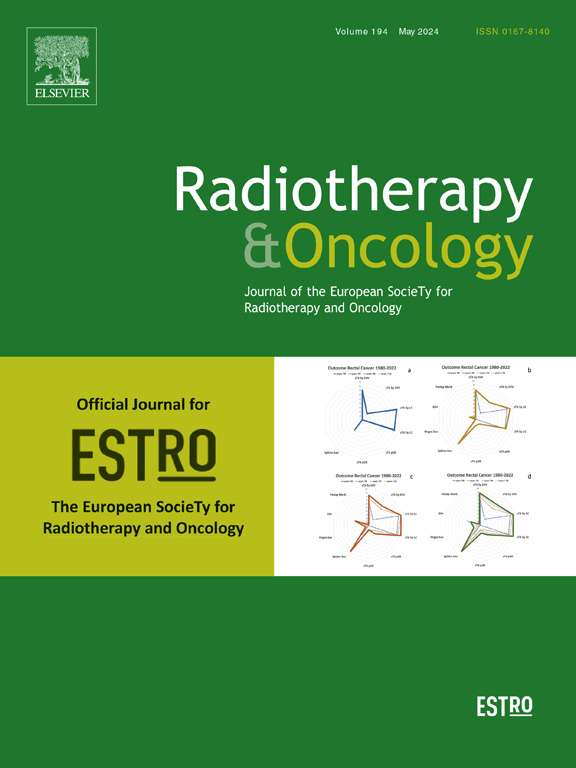在皮秒尺度上修改CERN- CLEAR-VHEE束流的微观结构可以改变ZFE的形态发生,但对过氧化氢的产生没有影响。
IF 4.9
1区 医学
Q1 ONCOLOGY
引用次数: 0
摘要
背景:FLASH放射治疗已成为放射肿瘤学的一项有前途的进展,显示出在保持肿瘤杀伤效果的同时最小化正常组织毒性的潜力。然而,临床翻译所需的精确光束参数仍有待完全确定。方法:为了优化临床应用的光束参数,我们在CLEAR设备上使用了能够靶向深部肿瘤的甚高能电子(VHEE)。这些与flash验证的中间能量电子束(IIE)和160-225 keV x射线束一起使用,共同提供从1 Gy/min到1011 Gy/s的剂量率。高通量化学分析研究了该剂量范围内的放射化学效应,而斑马鱼胚胎提供了体内模型来评估生物反应和发育结果。这项研究首次全面分析了从早期物理化学相互作用到复杂生物系统的各种剂量率和时间参数对闪速效应的影响。结果:来自CLEAR的数据表明,光束强度,特别是束电荷,是FLASH效应的关键决定因素,并揭示了当电子在皮秒时间尺度上传递时不可预见的生物反应。结论:我们的研究结果表明,采用高强度光束的扫描策略可能是临床实施FLASH放疗的最佳选择。这些见解对于指导放射肿瘤学中未来FLASH协议的发展至关重要。本文章由计算机程序翻译,如有差异,请以英文原文为准。
Modification of the microstructure of the CERN- CLEAR-VHEE beam at the picosecond scale modifies ZFE morphogenesis but has no impact on hydrogen peroxide production
Background
FLASH radiotherapy has emerged as a promising advancement in radiation oncology, demonstrating the potential to minimize normal tissue toxicity while preserving tumoricidal efficacy. However, the precise beam parameters required for clinical translation remain to be fully defined.
Methods
To optimize beam parameters for clinical application, we employed Very High Energy Electrons (VHEE) at the CLEAR facility, capable of targeting deep-seated tumors. These were used alongside a FLASH-validated Intermediate Energy Electron (IIE) beam and a 160–225 keV X-ray beam, collectively delivering dose rates from 1 Gy/min to 1011 Gy/s. High-throughput chemical assays investigated the radiochemical effects across this dose rate range, while zebrafish embryos provided an in vivo model to evaluate biological responses and developmental outcomes. This study offers the first comprehensive analysis of FLASH effects across a wide spectrum of dose rates and temporal parameters, from early physico-chemical interactions to complex biological systems.
Results
Data from CLEAR demonstrated that beam intensity, particularly bunch charge, is a critical determinant of the FLASH effect, and uncovered an unforeseen biological response when electrons are delivered over the picosecond timescale.
Conclusion
Our findings suggest that scanning strategies employing high intensity beamlets may be optimal for the clinical implementation of FLASH radiotherapy. These insights are pivotal for guiding the development of future FLASH protocols in radiation oncology.
求助全文
通过发布文献求助,成功后即可免费获取论文全文。
去求助
来源期刊

Radiotherapy and Oncology
医学-核医学
CiteScore
10.30
自引率
10.50%
发文量
2445
审稿时长
45 days
期刊介绍:
Radiotherapy and Oncology publishes papers describing original research as well as review articles. It covers areas of interest relating to radiation oncology. This includes: clinical radiotherapy, combined modality treatment, translational studies, epidemiological outcomes, imaging, dosimetry, and radiation therapy planning, experimental work in radiobiology, chemobiology, hyperthermia and tumour biology, as well as data science in radiation oncology and physics aspects relevant to oncology.Papers on more general aspects of interest to the radiation oncologist including chemotherapy, surgery and immunology are also published.
 求助内容:
求助内容: 应助结果提醒方式:
应助结果提醒方式:


